
Dairy Workers Suffocate in Manure
Confined Space Repost: Dairy Workers: Suffocating in Manure
Tim Craig has written a very good, if disturbing article in the Washington Post about hazardous conditions for dairy farm workers in Idaho.
Alberto Navarro Munoz had been working on the farm for only two weeks when he encountered one of the most gruesome hazards that a dairy worker can face. His tractor tipped over into a pit of cow manure, submerging the Mexican native under several feet of a “loose thick somewhat liquid-like substance,” according to the police report documenting his death in southern Idaho.
Another immigrant laborer jumped in to try to save Munoz, but told authorities “there was nothing he could do.” Munoz, whose body was later retrieved by the fire department, died of traumatic asphyxiation.
Munoz’s death, which occurred in the nearby town of Shelley last September, was one of two fatal accidents last year involving dairymen who either choked or drowned in pits of cow manure. Another laborer from Mexico died last month after he was crushed by a skid loader, used to move feed and manure.
Audrey Dutton milked this issue for the Idaho Statesman a few months ago, describing many of the same conditions that Craig covers, although Craig primarily focuses on the deadly hazards that the manure ponds present.
Most of the workers are immigrants which makes them especially vulnerable.
Farms have become increasingly reliant on immigrant workers, who often have minimal training or experience dealing with dangerous equipment and large animals. That has left farm laborers especially vulnerable to workplace deaths, such as being electrocuted, crushed by tractors, kicked by a heifer or beat up by a bull.
About 90 percent of the state’s 8,100 dairy farmworkers were born outside the United States. Nationwide, a little more than half of the dairy farms’ 150,000 employees are immigrants, according to the National Milk Producers Federation.
And statistics bear out the anecdotal tragedies. “There were 6,700 injuries on dairy farms with more than 11 employees in 2015 — a rate more than double the average for private industries. On those farms, 43 laborers died.”
Craig focuses on OSHA’s sincere, but inadequate efforts to address the problem of dairy farm workers, not only in Idaho, but previous efforts in Wisconsin and New York.
Over the last several years, OSHA launched Regional Emphasis Programs (REPs) in Wisconsin and New York which allows OSHA to focus its enforcement resources on a certain industrial sector, in this case dairy farms. REPs are always preceded by months or outreach and training for targeted employers.
Craig quotes employers (at least those interviewed in Wisconsin) who consider OSHA’s REP to be far too small to be effective. I find this interesting because I know from personal experience that employers in New York aggressively opposed OSHA’s dairy farm REP in New York, lobbying their Congressional delegation and state officials to shut down OSHA’s efforts, which they said would devastate the industry.
And one quibble. While most of the dairy farms are large, the hazards are the same on smaller farms. And Craig fails to mention that, due to a 40 year old Congressional budget rider, OSHA is not allowed to set foot on farms that have ten or fewer employees. No inspections, even as a result of a worker complaint, and no investigation or citations, even if one or more workers is killed.
The Post article states that Idaho employers are becoming alarmed at the fatalities in dairy farms, and making an effort to address the problem:
The Idaho Dairymen’s Association has budgeted $250,000 to train the state’s dairy workforce. The initiative began earlier this month when Westpoint Farms here in Jerome, Idaho, used an iPad to give workers a tutorial in Spanish outlining best practices for working with cows and navigating common hazards on a farm.
But, of course, we all know that safety is a function of both knowledge about hazard, as well as workers’ ability to exercise their rights to challenge hazardous working conditions without fear that they’ll lose their jobs. Worker advocates are skeptical of progress being made.
Indira Trejo, global impact coordinator for the United Farm Workers, said the danger of manure lagoons is just one of numerous threats facing dairy workers in Idaho. She said her organization has received scores of complaints from dairymen who say they are overworked and have limited access to safety training and bathrooms.
“All they want is our work and don’t care if we get training or not,” one immigrant dairy worker said through an interpreter. He asked not to be identified because he feared employer retribution.
“We know if you fall into a lagoon, the moment you step in, you disappear,” he said.